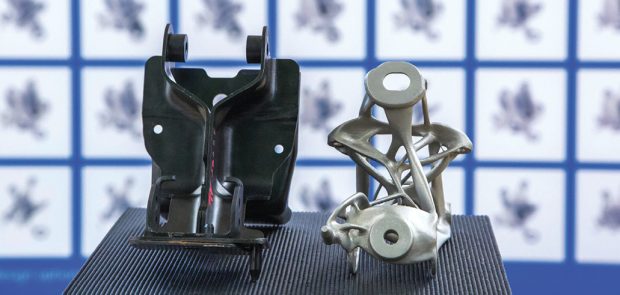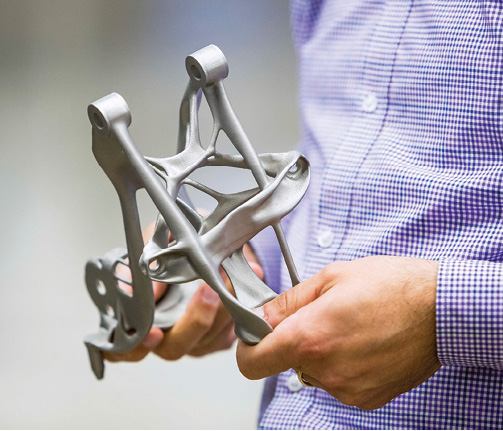July 1, 2018
In Warren, MI, in the GM Tech Center that dated all the way back to the Eisenhower administration, Paul Wolcott and Mike Van De Velde began scrutinizing a ubiquitous automotive component many of us take for granted—the seat belt fastener bracket. Wolcott, a GM application engineer for additive manufacturing, and Van De Velde, a GM design engineer, wanted to figure out a way to make the eight-piece assembly simpler and lighter.
 3D printing system developer Carbon’s Digital Light Synthesis technology plays an integral role in the textured midsole of the Adidas Futurecraft 4D shoes. Image courtesy of Carbon.
3D printing system developer Carbon’s Digital Light Synthesis technology plays an integral role in the textured midsole of the Adidas Futurecraft 4D shoes. Image courtesy of Carbon.With metal-based additive manufacturing, the bracket could be remade with fewer parts, possibly as a single consolidated part. But what is the best possible shape—a shape that’s both light and strong? To help them find the answer, the two colleagues enlisted the help of a non-human collaborator—generative design software from Autodesk.
Generative Design vs. Topology Optimization
Leading automotive manufacturers have already embraced topology optimization, the use of algorithm-driven software that helps designers identify the best (or optimal) geometry based on anticipated loads, stress, pressure and other parameters. Generative design, some believe, is a more advanced version.“Unlike topology optimization, the [generative design] software explores all the possible permutations of a solution, quickly generating design alternatives. It tests and learns from each iteration what works and what doesn’t,” according to Autodesk’s description of generative design.
The artificial intelligence-like software takes into account user-provided design parameters, then spawns design families and variants, some with better performance than others. This generative process can be repeated until the designer is satisfied he or she has discovered a shape that meets all the desired characteristics, such as structural integrity, aesthetic appeal and manufacturability.
At Autodesk, generative design originated as a technology preview, codenamed Project Dreamcatcher. It’s now part of Autodesk Fusion 360, the design software maker’s cloud-hosted software suite. GM was “the first automaker in North America to use new generative design software technology from Bay Area-based software company Autodesk,” according to GM’s press announcement in May.
The Embedded Team
The GM-Autodesk alliance goes beyond the perfunctory press releases and handshakes. The software maker, in fact, installed a team of software engineers to be on site at the GM Tech Center. The help was, quite literally, hands on, according to Bob Yancey, Autodesk’s director of manufacturing industry strategy.For most generative design users, such a close working relationship with the software developer may not be necessary, but, in this case, it was for mutual benefit, Yancey explains. “We bring our expertise in generative design, which includes how best to frame the design problem and set up constraints for the software. We also get to observe first-hand how a key customer is deploying the technology,” he says.
 Originally an eight-piece assembly, GM uses Autodesk generative design software to redesign the component into a single 3D-printed piece. Image courtesy of Autodesk.
Originally an eight-piece assembly, GM uses Autodesk generative design software to redesign the component into a single 3D-printed piece. Image courtesy of Autodesk.Whereas simulation software (such as structural analysis, flow simulation and multiphysics simulation) is well-established, generative design is relatively new, considered by some to be experimental. So if it can prove itself in a GM project, it could become more appealing to other household names in the automotive sector. “Generative design is still a new technology to many engineers and we’re available to assist,” says Yancey.
From 8 to 1
The redesigned seat belt bracket is no longer a multi-piece assembly but a single component, weighing 40% less but 20% stronger, Autodesk stated in a blog post (“How GM and Autodesk are using generative design for vehicles of the future,” May 2018, In the Fold).In its own press release on the partnership with Autodesk, GM wrote, “Eliminating mass in parts where material is not required for performance, combined with parts consolidation, yields benefits for vehicle owners, including the potential for more interior space and vehicle content, increased range and enhanced vehicle performance.”
“For the seat-bracket project, the constraints included attachment points, geometric envelope, strength, mass and manufacturing method—in this case, metal additive. Knowing the manufacturing method very much impacts the process,” says Yancey. “The software output over 150 design options, which are prevalidated for the chosen manufacturing method.”
Generative Design Residency at Pier 9
As part of the partnership, Wolcott and Van De Velde also flew to San Francisco to further explore Autodesk technology in a two-week generative design residency. The residency took place in the Autodesk Pier 9 workspace, located by the San Francisco waterfront.“Talking to Autodesk folks, we came to a better understanding of where we could use the software, and where we shouldn’t. The generative design software was very advantageous when used for part consolidation, but perhaps not suitable in crash analysis,” recalls Wolcott. The current generation of generative design and topology optimization software “tends to work in linear scenarios,” he observes, “so applying nonlinear load cases to them is difficult.”
He suggested using generative design and topology optimization upfront in the development process to get “a coarse design, then using mainstream computer-aided engineering (CAE) tools to perform crash simulations.” At the end of the residency and the partnership, Wolcott came to realize “generative design is more of an iterative process than a set-it-up-and-hit-the-button type of workflow.”
There is a learning curve to understand how to set up the boundary conditions and inputs for the software, Wolcott says, and his own CAE background was a big help. “As you change the loads, the output changes, too. Sometimes the output is not what you’d expect. So you need to be able to study it and understand why the software solves it this way,” he explains.
3D-Printed Sole
The next time you slip your feet into a pair of Adidas shoes for a jog, you just might be sprinting on 3D-printed soles made with Digital Light Synthesis (DLS), a technology from Carbon. “[We work] at the intersection of hardware, software and molecular science,” the California-based 3D printing technology developer Carbon states. “Our vision is a future digitally fabricated with light, where traceable, final-quality parts are produced at scale with CLIP (continuous liquid interface production) technology.”In January, Adidas’ executive board member Eric Liedtke also became part of Carbon’s board of directors. This follows Adidas’ investment in Carbon in December 2017. Announcing the Series D funding at the time, Carbon stated, “The unprecedented Adidas Futurecraft 4D is a proven example of the power of true digital 3D manufacturing today, creating unlimited possibilities for designing, engineering, making and delivering truly innovative products.”
Carbon developed the Futurecraft 4D model exclusively for Adidas, but, “Carbon’s digital 3D manufacturing solution is also used by many other customers to produce a variety of products, such as commercial blender parts for Vitamix, mobile device protection for Incase, denture molds, pediatric airway stents, tuberculosis diagnosis tests and automotive parts,” says Philip DeSimone, cofounder and VP of business development at Carbon.
Flexing AM Muscles
Traditionally, athletic shoes have three-layer soles made of a mix of ethylene vinyl acetate, polyurethane and liquid silicone. Sandwiched between the insole and the outsole, the midsole layer functions as the cushion to provide comfort (“Running Shoe,” How Products are Made).But the Adidas soles made with DLS take a dramatic departure from this traditional method. “The Carbon team developed a proprietary print strategy for midsoles that enables printing with essentially zero support material. This not only saves on raw material costs, but also dramatically reduces manual post-processing steps of traditional additive manufacturing,” according to Carbon’s blog post on the project (“The perfect fit: Carbon + Adidas collaborate to upend athletic footwear,” April 2017, carbon3d.com).
The Futurecraft 4D’s midsoles, manufactured using DLS technology, consist of intricate lattice structures, providing shock-absorbing functionality with far less material than solid pieces. “With [Carbon’s] Digital Light Synthesis, we venture beyond limitations of the past, unlocking a new era in design and manufacturing—one driven by athlete data and agile manufacturing processes,” says Liedtke.
“Now able to create and customize complex geometric structures based off of insights from 17 years’ worth of athlete data, Adidas could design midsoles that precisely address the specific requirements of movement, cushioning, stability and comfort, all in one single component,” notes DeSimone. “This is breaking new ground for the industry, given the limitations of current shoe production standards in which midsoles cannot be injection or compression-molded with properties that vary across the part, unless multiple parts are assembled through a labor-intensive process.”
 GM and Autodesk partnered to explore the use of generative design technology to redesign a seat belt bracket. Image courtesy of Autodesk.
GM and Autodesk partnered to explore the use of generative design technology to redesign a seat belt bracket. Image courtesy of Autodesk.Both generative design and additive manufacturing are comparatively new technologies, with lots of room for exploration as well as improvement. Progressive manufacturers like GM and Adidas stand to benefit from their involvement to shape the technology to fit their domain-specific needs.
More Info
AdidasSubscribe to our FREE magazine, FREE email newsletters or both!
About the Author
Kenneth Wong is Digital Engineering’s resident blogger and senior editor. Email him at [email protected] or share your thoughts on this article at digitaleng.news/facebook.
Follow DE





